Work Patterns
Please note that this is a preview feature that must be enabled before using. Read more about how to enable the feature here.
The new Work Pattern feature enables HR Managers to schedule irregular working times easily. This is especially useful for employees who do not work "9 to 5" on weekdays: part time employees, apprentices, working students, seasonal workers and shift workers.
Detailed working hours can be entered in work patterns. It is even possible to create several work patterns for different time periods in an employment terms (e.g. in the case of working students: one work pattern for the semester break, one work pattern for the time during the semester). Furthermore, a work pattern can easily be replaced within the contract if only the working times change but the employment terms itself remains the same. This saves administrative efforts and reduces the risk of errors. Overall, work patterns provide flexibility and more accurate data in the system regarding employees' working hours, as even complex time arrangements can be reflected.
Creation of Work Pattern Templates
We recommend the use of work pattern templates because they can be applied to multiple employment terms and employment terms templates, saving time in the process of setting up an employee in the system.
Firstly, navigate to Settings in the lower left corner and click on Work Pattern Templates in the navigation bar on the left side.
Here, the default view gives you an overview on all active work pattern templates and some basic information about them.

Click +NEW to create a new work pattern template, or choose one to edit.
Additional Information: When the work pattern template is edited after it is connected to an employment terms which is set valid, the changes will not affect the employment terms.

The following fields need to be filled:
- Name: The name of the work pattern template, e.g. "Apprentices in IT", "3-Shift-System", …
- Recurrence: This defines the recurrence mode of the work pattern. "Pattern Sequence" means that the work pattern repeats itself over and over again. "Yearly" means that the work pattern is repeated on a yearly basis. Please find an example for yearly recurrence below.
- Pattern First Day: Here, you have the option to define the weekday on which the work pattern starts.
Which impact does the 1st day of the work pattern have?
If you do not define a first day of the work pattern, it will simply start with the first work pattern detail on the start date which can be defined in the employment terms.
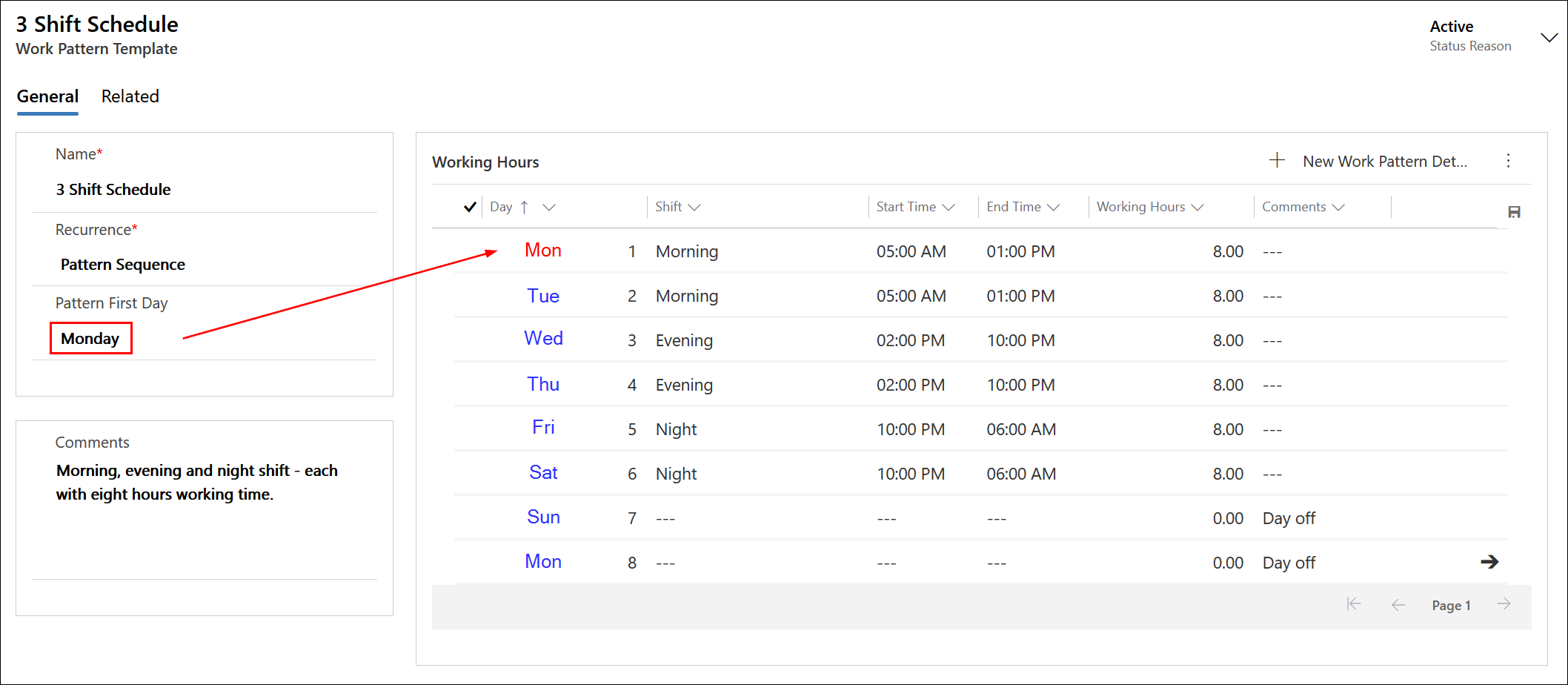
If you define "Monday" as the first day of the work pattern and then define a start date (in the employment terms) which is not a Monday but a different day of the week (e.g. February 1 is a Wednesday), then the system will start the work pattern with the first work pattern detail which falls on the Wednesday:

Once the mandatory fields are filled and the record is saved, the working hours can be defined in the grid on the right side. Click on +New Work Pattern Detail in order to add working times.

The Quick Create form opens. Define the Day of the work pattern detail. This must be a unique and sequential number.
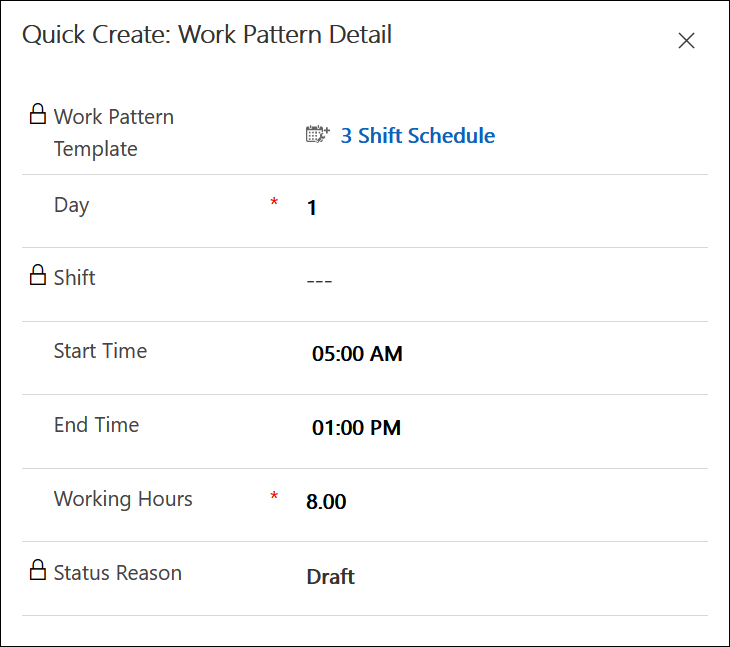
Then, you have the option to add a Shift to the work pattern detail. If you do so, the start and end time which is defined in the shift will be copied into the work pattern detail (you can see this in the grid once you click Save and Close).
You also have the option to define the working times without adding a shift in the fields Start Time and End Time.
Lastly, please define the number of allocated hours in the field Working Hours.
Please note: The working hours (= target hours) entered here are the only parameters that are relevant for the system, e.g. for absence management. The number of hours entered here corresponds to the net working time of the employee (without breaks).
The start and end times are only a purely informative indicator of when the employee is to work. They have no effect on absence management.
Here it is possible to specify a longer period than the target working hours in order to represent flexitime regulations. For example: Start time is 8 AM, end time 8 PM, working time 8 hours. Within this time period, the employee can work 8 hours, but when exactly is up to him.

Now, please click Save and Close and add as many work pattern details as you like.
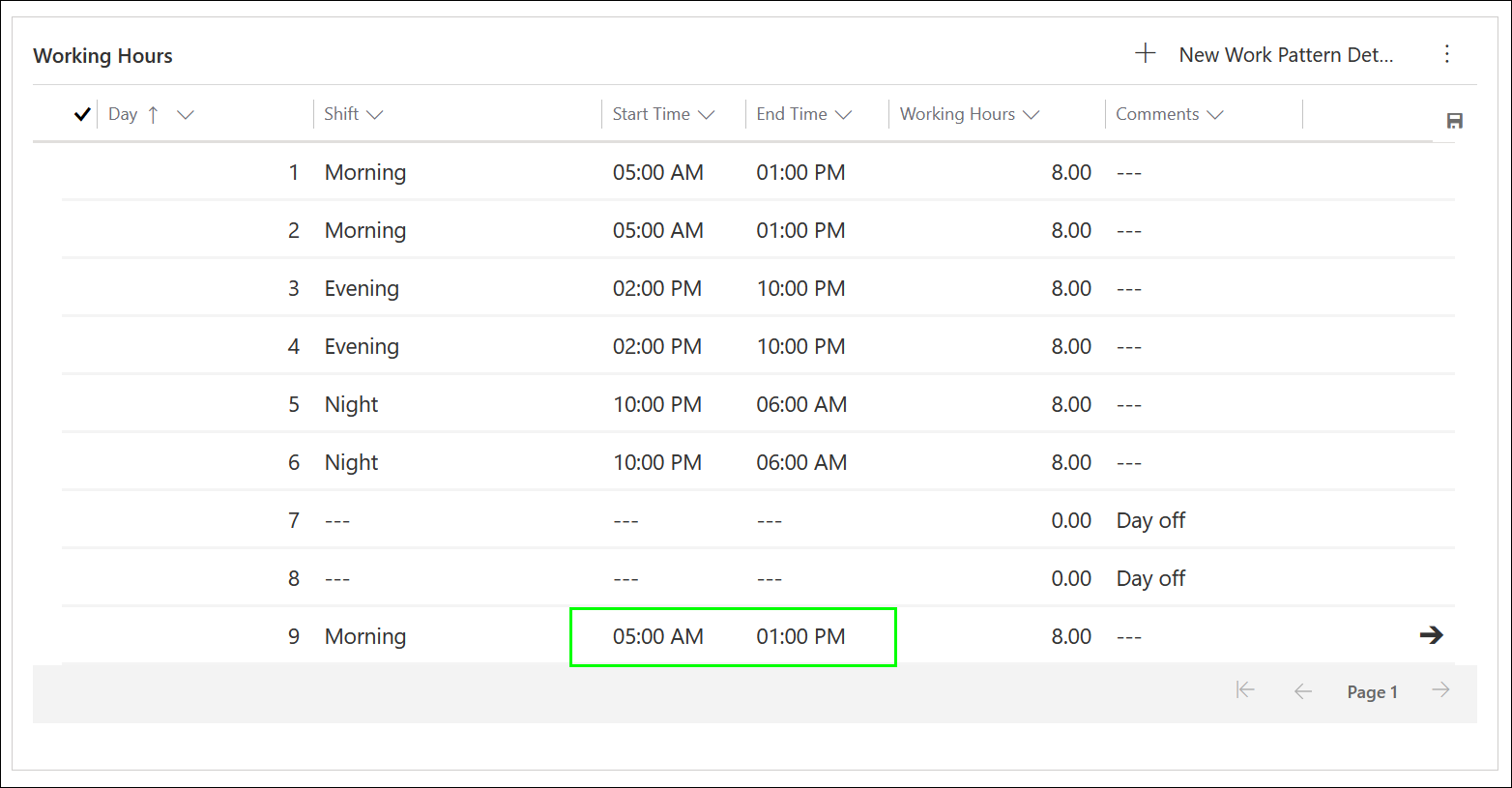
Please keep in mind to add "empty" days for the weekends / days off work. Just add a Work Pattern Detail with 0 Working Hours.
Creation of Work Patterns
Work Patterns can be created in the employment terms when the flip switch "Enable Work Pattern" is set to YES, or from the menu option Work Pattern in the navigation bar in the HR Hub.
In the employment termsyou will find a rcommendation text (in the "light bulb switch") regarding employment terms which are already valid. It is also possible to add a work pattern here, but the "Enable Work Pattern"-flipswitch button can then no longer be switched back to "No".

As soon as you set the toggle switch to "Yes", you can add the work patterns in the "Work Patterns" tab at the top and edit them later. If you do not activate the function, you will still find the previous, static working times of the employee in the tab "Working Hours".

You can add a new work pattern in the tab "Work Patterns" by clicking on +NEW Work Pattern on the right.
The process is similar to the creation of a work pattern template (in the employment terms there are fields for the time period of the work pattern and a setting regarding the holiday calendar). Please fill in the fields and savethe record to add the work pattern details (days). To do this, click on +NEW work pattern detail.
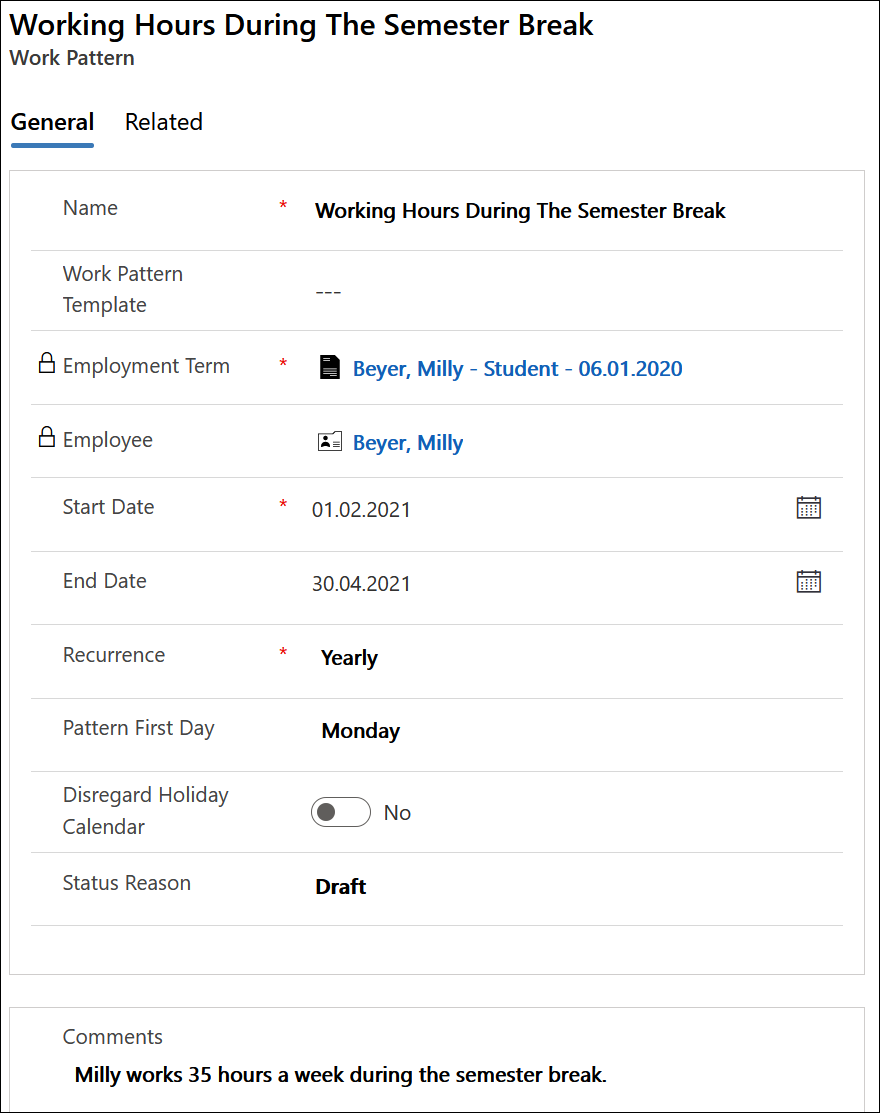
- Start Date & End Date: Please define the time period of the work pattern. It is possible to add multiple work patterns to one employment terms. Please make sure to cover the whole duration of the contract with a work pattern or multiple work patterns with no gaps in between them. For permanent contracts this means to set the "last" work pattern without an end date and choose pattern sequence as recurrence mode. Please note that it is possible to have an "empty" work pattern (= no working hours) as a filler between two work patterns.
- Disregard Holiday Calendar: This field is relevant for the leave calculation. When this is set to YES, the leave request will be calculated solely based on the work pattern, otherwise the holiday calendar will be taken into account. Also, this setting impacts the Daily Summary: When "Disregard Holiday Calendar" is set to "Yes", on a holiday specified in the calendar, the employee has 0 leave hours and the normal allocated hours. The day is flagged for Payroll.
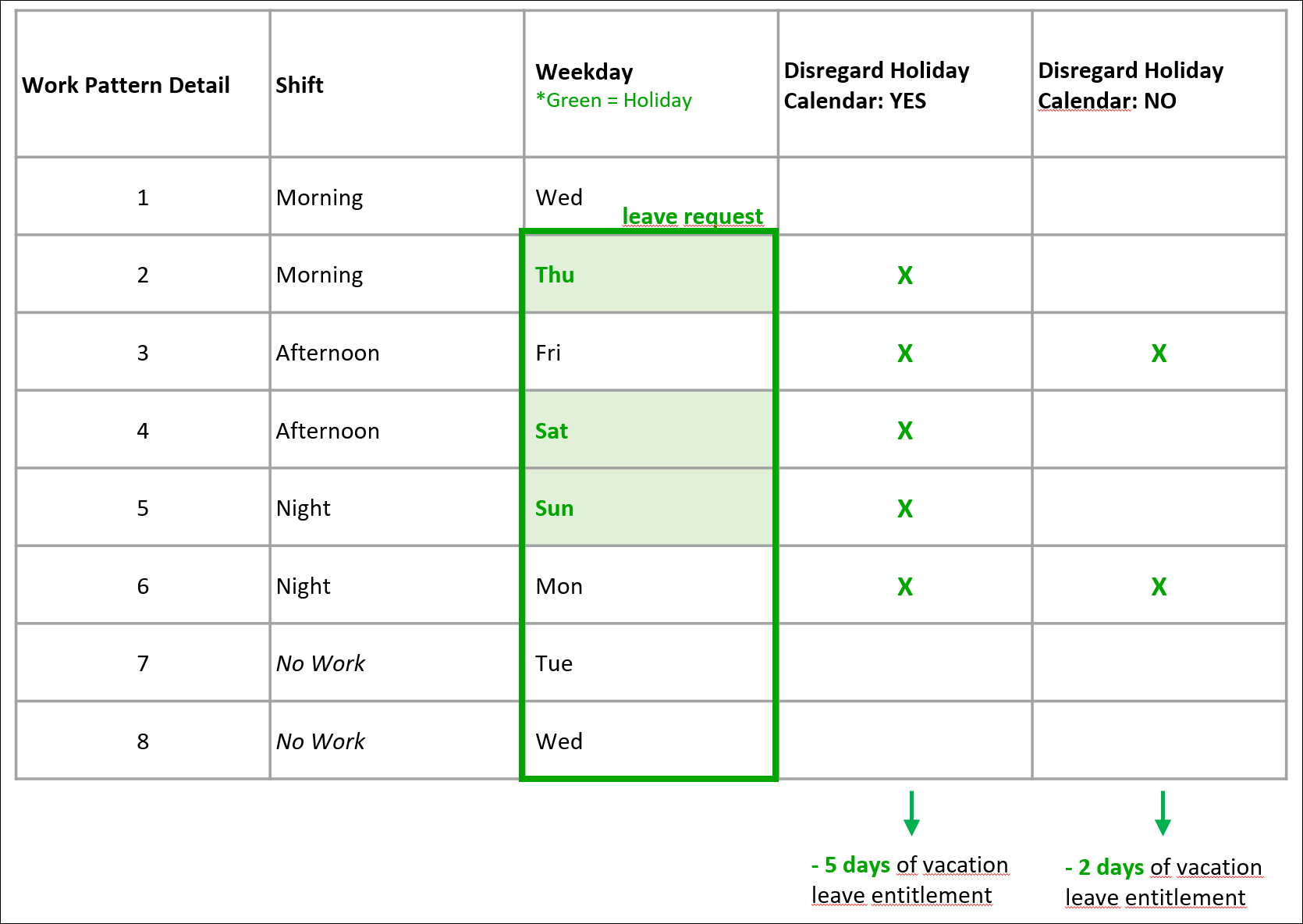
- Additional Information for Yearly Recurrence:
If there are not enough work pattern details to fill the time period between the start and end date, the work pattern details will repeat themself within this time period. Furthermore, the time span from start date to end date repeats on an annual basis. Let's have a look at the use case of a seasonal worker who works 40 hours per week from 1st of May to 31st August every year. Here, you would set the dates accordingly, and then only define 7 work pattern details:
Day 1-5 have 8 allocated hours each.
Day 6-7 have 0 allocated hours (= weekend).
Now, this week repeats itself from 1st of May until the 31st August every year. This saves you a lot of time because you do not have to create 120 work pattern details to define every single day in this time period. Now you can create a second work pattern with 0 working hours for this use case, which fills the period of the rest of the year.
At this point you are finished with setting up the work pattern. As soon as the employment terms is set to valid, all the work patterns it contains are also set to valid. If an employee's working hours change, you can replace the work pattern (similar to a salary, for example).
You can find more information below.
Work Patterns: Further Information
With the introduction of Work Patterns, the Daily Summary will become the "single source of truth" for all attendance and leave related information. Not only the work pattern, but also the employment terms, holiday calendars, leave request, leave calendars, etc. will rely on the information stored in the daily summaries.
With the work pattern enabled, the leave management is calculated accordingly. The absence calendar shows the days where the employee does not have allocated hours.
If no daily summaries are existing for a specific time period in the future, the system will project the situation of working hours for the employee based on the work pattern of that employee in combination with the relevant calendars.
The existing working hours functionality based on Employment Terms will remain in the solution. We recommend to use this function for employees who have regular working hours.
How many work patterns can one employee have?
One Employment Terms can have multiple Work Patterns linked to it. It is important in general, that the whole duration of the contract is "covered" by a work patterns. This means that there should not be any gaps between them. If there are more than one work patterns associated with an employment terms, please make sure that they do not overlap.
This also means that if the employee has a permanent contract, the (last) work pattern should be without an end date.
In which case would an employee have multiple work patterns?
- Working Students (they work max. 20 hours during the semester, up to 40 hours in the semester holidays. For this case, you can create one work pattern which is applicable during the semester and define the respective start and end date, and then one full-time work pattern which is applied in the semester holidays)
- Seasonal Workers (they work full-time during the summer, and do not work during winter. Here, a full-time work pattern can be created which covers the summer period, and a work pattern with work pattern details with 0 working hours which repeats itself until the end of winter)

Can a work pattern be edited?
Once an employment terms is set to valid, the work patterns linked to it are set to valid, too, and cannot be edited anymore. If you want to do this, you need to replace the work pattern. This gives transparency about the deprecated work patterns of an employee. As long as the contract or the work pattern itself are not set to valid, it can be edited.
Can work patterns be added to already valid employment terms? (relevant for existing customers)
Yes, we have added a functionality here, so that our existing customers are able to switch their employees to work patterns without replacing the whole contract. In valid contracts, the toggle button "Enable Work Patterns" can be set to "Yes". However, once the functionality is enabled for a valid employment terms, the switch cannot be flipped back anymore.
Is it possible to define "normal", static working hours with a work pattern?
Yes, it is possible to enter regular working hours as a work pattern. Please choose Sequence as recurrence mode and add 7 work pattern details (= 7 days). Set the work pattern to start on "Monday" and enter the working hours. Day 6 & 7 should have 0 allocated hours because these days are Saturday and Sunday.
